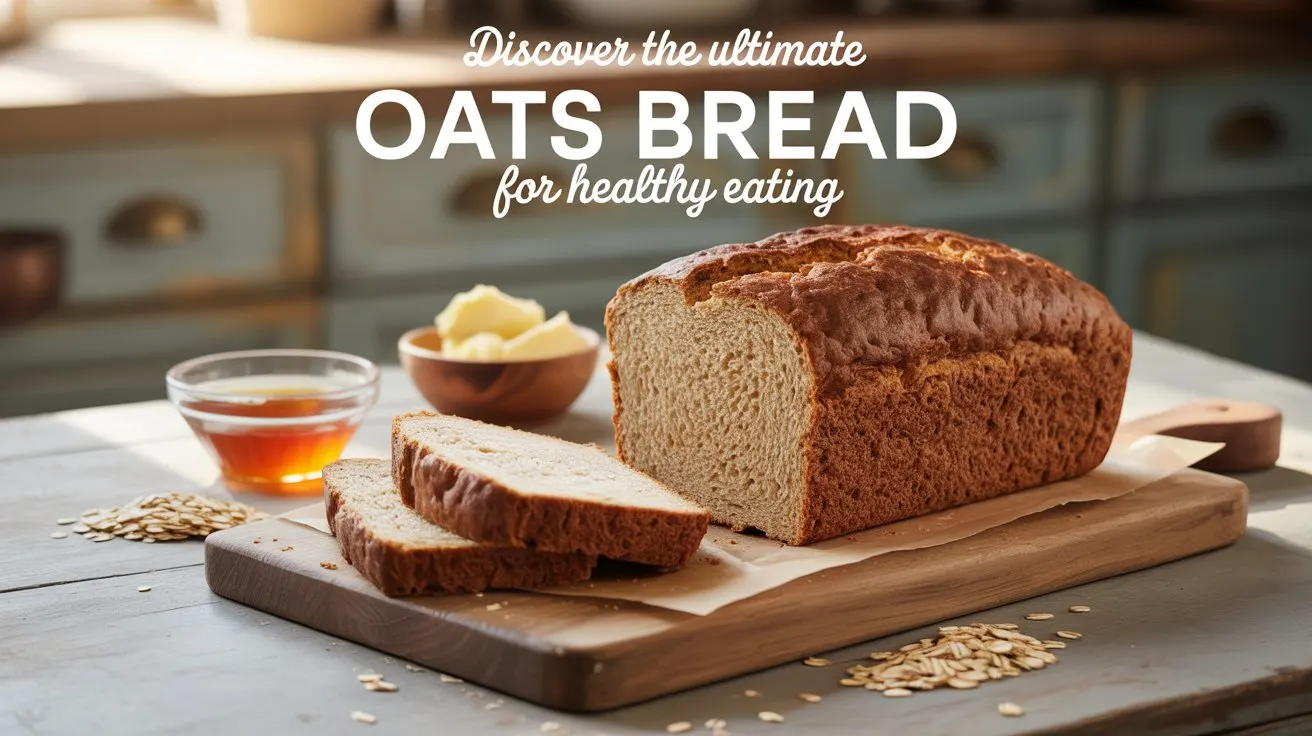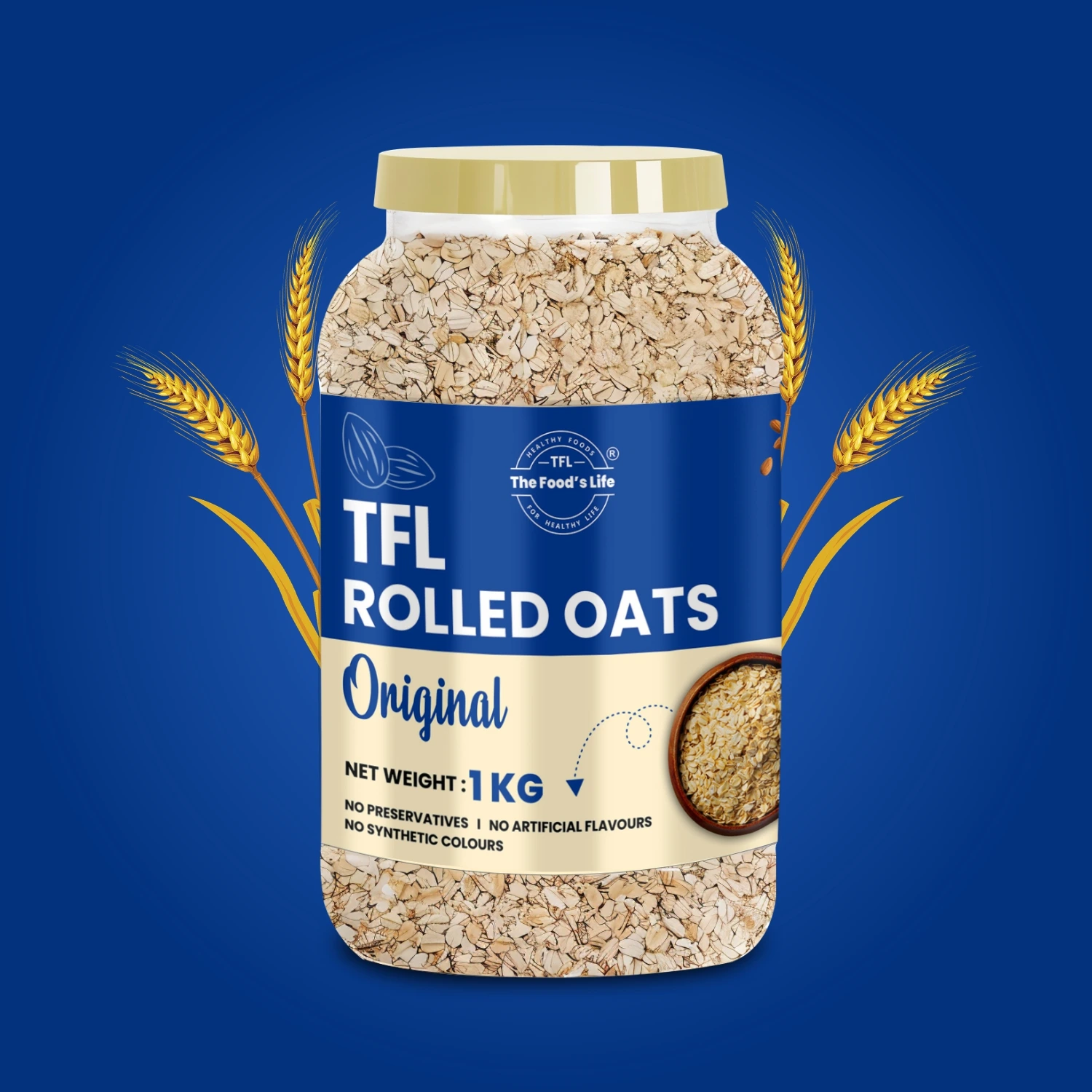Oats bread is nutritious, high in fiber, and filling, so if you are looking for a nutritious alternative to regular bread, then oats bread is a great choice. Oats bread is a nutrient-packed loaf of bread made from oats. It aids digestion, stabilizes energy, and fills you up. You can have oats bread in sandwiches, or you can enjoy it toasted with whatever you're craving spread on top, oats bread fits into a healthy lifestyle just fine.
When you make oats bread at home, you use simple ingredients like oat flour and whole grains, and you get to combine all the health benefits of oats into one versatile loaf of fresh bread. And if you're looking for a gluten free oat bread, you can always switch to a certified gluten-free oats, and the end result will meet your gluten-free dietary needs!
What I think is important about oat flour bread, is not only is it nutritious, but being soft and slightly earthy in flavor, it is great for breakfast or snacks. Oats bread is reliable for anyone who is trying to incorporate nutritional health into their diet while still enjoying something that tastes good.
Why You Should Try This Oats Bread Recipe at Home
Oats bread is more than a fad on a bakery shelf: it’s a delicious and healthy option to make if you’re in your own kitchen. If you haven’t made your own oats bread, now is the perfect time. Oats bread is a well-balanced, nutritious, and tasty option for when you’re hungry. It’s satisfying and filling without being heavy, for breakfast, lunch, or dinner.
Nutritional value of oats bread for everyday meals
- High in Dietary Fiber: Oats bread is a great way to include fiber in your diet, particularly beta-glucan, which promotes digestion and heart health.
- More Plant-Based Protein: Oats bread has more protein than standard white bread - helpful for muscle healing and satiety.
- Healthy Blood Sugar Carbs: Oats bread has healthy, complex, low-glycemic carbs that will provide energy without a spike throughout the day.
- Rich in Micronutrients: Oat flour bread has essential vitamins and minerals like magnesium, phosphorus, and zinc for bone support, and possible immune support.
Homemade oat flour bread vs. store-bought loaves
- No Preservatives: When you bake your own oats bread, you are avoiding the preservatives and unnecessary additives that are in packaged bread.
- Customizable Ingredients: You control the type and quality of the ingredients, choosing organic oats, nuts, seeds, or spices if you prefer.
- Taste it Fresher: Fresh baked oat flour bread always has a heartier and rich nutty flavor that store bought bread typically lacks.
- Nutrition: Most commercial oat loaves use refined flour. On the other hand, to make homemade oats bread you will always be using 100% oat flour or whole grains rather than refined flour so the nutritional value is better.
Why baking your own gluten free oat bread is worth it
- Safe for gluten sensitivities: Certified gluten free oats ensures your gluten free oat bread is safe for anyone suffering from celiac disease or gluten intolerance.
- Naturally nutritious: Oats are naturally gluten free and jam packed with nutrients so when you use gluten free certified oats, you are not only providing a safe loaf but a nutritious one.
- Cost effective: Baking your own gluten free oat bread is much more cost effective than taking a chance at the higher priced gluten free loaves sold in retail outlets.
- Fresh every time: Opening the oven to the aroma and taste of freshly baked oats bread is second to none.
The Essential Ingredients for Perfect Oats Bread
The process for the best oats bread recipe starts with choosing the right ingredients. All the ingredients have a function in the resulting loaf, whether it be delicious and solid, or a loaf with lots of nutrition. Let's assume that you are just baking a regular loaf of bread and want to use oats, or you are making gluten free oat bread at home. The following ingredients will help you reach the development of creating the right combination of texture, flavor and nutritional value.
Oat flour: the base of a nutritious oat flour bread
- Nutrient-Rich Base: Oat flour is the MVP on any oat flour bread; full of fiber, and gratifying flavor that is wholesome and slightly sweet.
- Gluten Free Substitute: If oat flour is made from certified gluten free oats than it fits perfectly for someone who wants to avoid gluten. Oat flour becomes another staple in your gluten free oat bread.
- Soft and Fine Texture: Oat flour is milled from whole oats, so there should be a soft yet dense crumb to the bread that will be fulfilling and easy to machine down.
Rolled oats and whole wheat flour for texture and fiber
- Rolled oats: Including rolled oats in your oats bread recipe gives the loaf texture and adds more fiber. They also make it pretty on top and in the loaf itself while adding a rustic look that highlights it's homemade.
- Whole wheat flour: Using whole wheat flour with oat flour provides balance in texture and adds a protein and nutrient boost. It aids in structure of the dough, as well as ensuring a good rise during baking.
- Fiber-rich blend: Both rolled oats and wheat flour are high in fiber and help aid digestion while providing sustained energy, which is exactly what you want for an everyday oats bread to take you through the day.
Yeast, olive oil, and natural sweeteners for flavor and rise
- Yeast: You need yeast to leaven the bread because it helps to aerate it and yeasts is the key for creating a light and fluffy oats bread as it enables your oat loaf to rise, turning dense flour into a soft airy loaf.
- Olive oil: A little splash of olive oil adds richness, moisture and healthy fats which allows for the crumb to soften while prolonging shelf life.
- Natural sweeteners: A hint of honey, maple syrup, or mashed banana to your bread adds a mild sweetness and improves the depth of flavor without using refined sugar.
Step-by-Step Oats Bread Recipe Instructions
Baking the perfect oats bread at home is a satisfying and healthy endeavor. Whether you’re making traditional or gluten free oat bread, the process is simple when broken down into clear, manageable steps. Follow this comprehensive guide using wholesome ingredients like oat flour and rolled oats to create a nourishing loaf that’s rich in flavor and nutrition.
Mixing ingredients for perfect consistency
A great oats bread recipe begins with balanced ingredients mixed to the right consistency.
- Start with the dry mix: In a large mixing bowl, combine 1½ cups oat flour, 1 cup whole wheat flour (or more oat flour for gluten-free), ½ cup rolled oats, 1 teaspoon salt, and 1 tablespoon natural sweetener like honey or maple syrup.
- Activate the yeast: In a separate cup, mix 2 teaspoons active dry yeast in 1 cup warm water. Let it sit for 5–10 minutes until it becomes frothy.
- Combine wet and dry: Pour the yeast mixture and 2 tablespoons olive oil into the dry mix. Stir until a sticky dough forms.
- Knead lightly: On a floured surface, knead the dough gently for 5–7 minutes until it becomes soft but not sticky. If making gluten free oat bread, reduce kneading time and handle delicately to maintain structure.
Proofing and shaping your oats bread dough
Allowing the dough to rise properly ensures a light, fluffy oat flour bread.
- First rise: Place the dough in a lightly greased bowl, cover with a cloth or wrap, and let it rise in a warm spot for 60–90 minutes or until doubled in size.
- Shape the dough: Once risen, punch down the dough and shape it into a loaf or place it in a loaf pan lined with parchment paper. For a rustic look, sprinkle rolled oats on top.
- Second rise: Let the shaped loaf sit for another 30–45 minutes. This final proof enhances the softness and gives the oats bread its final structure.
Baking tips for soft and golden oat flour bread
Proper baking is key to achieving a loaf with a golden crust and soft interior.
- Preheat the oven: Set your oven to 375°F (190°C). Preheating ensures even cooking from the start.
- Bake the bread: Place the loaf on the center rack and bake for 30–35 minutes or until golden brown on top and the loaf sounds hollow when tapped on the bottom.
- Cool before slicing: Let your oats bread cool on a wire rack for at least 30 minutes before cutting. This keeps the inside moist and prevents crumbling.
Tips for Baking Gluten Free Oat Bread Successfully
Baking a delicious gluten free oat bread at home can be incredibly rewarding—especially when done right. Without gluten’s natural elasticity, it’s essential to adjust your techniques and ingredients to get that perfect texture and flavor. Whether you're following a special diet or simply seeking a healthier alternative, here’s how to master a gluten free oats bread recipe with ease.
How to use certified gluten-free oat flour
The foundation of any oat flour bread lies in selecting the right oat flour.
- Always choose certified gluten-free oat flour to avoid cross-contamination with wheat or barley.
- Store-bought oat flour offers consistency, but you can also blend rolled oats at home for a fresh, flour-like texture—just ensure the oats are certified gluten-free.
- Mix oat flour with other gluten-free flours like almond or brown rice flour to enhance structure and add depth to your oats bread.
Binding agents that help gluten free oat bread hold together
Since gluten is the “glue” that gives bread its elasticity, gluten free oat bread needs alternative binding agents to hold its shape and texture.
- Psyllium husk, flaxseed meal, or chia seeds work wonderfully as natural binders. Mix 1 tablespoon of any with 3 tablespoons of water and let it sit for 5–10 minutes to gel before adding to your dough.
- Eggs also provide excellent binding, moisture, and structure (for those who consume them).
- A small amount of tapioca or arrowroot starch can add elasticity and mimic the chew of traditional bread.
Preventing dryness and maintaining moisture
One of the biggest challenges with gluten free oat flour bread is keeping it moist.
- Add moisture-rich ingredients such as olive oil, yogurt (dairy or non-dairy), or applesauce to your batter. These help soften the crumb and enhance flavor.
- Don’t overbake—gluten free oats bread can dry out quickly. Use a toothpick test to check doneness and remove from the oven as soon as it’s clean.
- Once baked, wrap your loaf in a kitchen towel or store in an airtight container to maintain moisture longer.
Creative Ways to Customize Your Oats Bread Recipe
Homemade oats bread is a nourishing, gluten-friendly option that brings together taste, texture, and nutrition. But what makes it even more special is the way you can personalize every loaf. From subtle spices to crunchy seeds and from sweet dried fruits to savory herbs—there are endless possibilities to elevate your basic oats bread recipe. Let’s explore how to make your gluten free oat bread stand out with simple, wholesome ingredients.
Adding herbs, seeds, or nuts to enhance flavor
Adding herbs, seeds, or nuts is one of the easiest ways to boost the flavor profile and nutritional content of your oats bread.
- Sunflower Seeds & Pumpkin Seeds: These seeds are rich in magnesium, iron, and healthy fats. Fold them into your dough or sprinkle them on top for a delightful crunch in every bite.
- Flaxseeds or Chia Seeds: Great for digestion and packed with omega-3 fatty acids, these seeds can also act as binding agents in a gluten free oat bread.
- Almonds, Walnuts, or Pecans: Chop and stir into the dough for added protein and a hearty texture. These nuts work wonderfully in both sweet and savory recipes.
- Fresh or Dried Herbs: Add rosemary, thyme, or oregano for aromatic depth. These herbs transform a simple oat flour bread into a bakery-style artisan loaf.
Using these add-ins not only enhances taste but also aligns with health-conscious baking. These ingredients are naturally gluten-free, making them ideal for any gluten free oats bread recipe.
Sweet oat flour bread with cinnamon and raisins
Transform your basic loaf into a breakfast favorite or a midday snack with this sweet version of oat flour bread.
- Ground Cinnamon & Vanilla Extract: Adding cinnamon lends warmth, while vanilla enhances the natural sweetness of the oats.
- Raisins or Dried Cranberries: These are classic choices for sweet oats bread, adding chewy texture and subtle sweetness without refined sugar.
- Banana or Applesauce: For added moisture and a fruity flavor, replace part of the liquid in the oats bread recipe with mashed bananas or applesauce.
- Maple Syrup or Honey (if not strictly vegan): These natural sweeteners can be used in small amounts for a deeper, caramelized flavor.
This sweet version of gluten free oat bread is perfect served warm with nut butter, or sliced and toasted as a fiber-rich breakfast alternative.
Making a savory gluten free oat bread with garlic and herbs
For those who enjoy bold, savory flavors, a garlic-and-herb gluten free oat bread is an excellent option.
- Minced Garlic: Lightly sautéed garlic gives the bread a rich, umami undertone. Stir into the dough or press onto the top crust before baking.
- Italian Herb Blend: Dried basil, oregano, and parsley can elevate the flavor of oat flour bread, making it perfect for pairing with soups or pasta.
- Nutritional Yeast or Vegan Cheese: Add a cheesy flavor and extra protein to your bread while keeping it plant-based and healthy.
- Coarse Sea Salt & Cracked Pepper Topping: Sprinkle on top for a rustic bakery finish and extra savory bite.
This variation of oats bread works beautifully for sandwiches, dipping in olive oil, or serving as a side to hearty meals. It’s a great way to make a wholesome, gluten free oat bread feel indulgent and satisfying.
Health Benefits of Including Oats Bread in Your Diet
Oats bread is more than just a nutritious, homemade delight—it’s a powerful functional food that supports your body from the inside out. Made from simple, wholesome ingredients like oat flour, rolled oats, and other natural additions, this bread is a smart everyday choice. Whether you're baking a classic oats bread recipe or opting for a gluten free oat bread, the health benefits are truly impressive.
Oats bread for fiber and digestive health.
One of the standout features of oats bread is its high fiber content, especially when using whole grain oat flour and rolled oats.
- Soluble Fiber (Beta-Glucan): This special type of fiber found in oats helps promote digestive regularity, relieve constipation, and improve gut microbiota.
- Improved Satiety: The fiber in oat flour bread helps you feel fuller for longer, which can be beneficial for weight management and reducing overeating.
- Gentle on the Digestive System: Gluten free oat bread, made from certified gluten-free oats, is an ideal option for those with gluten sensitivity or digestive discomfort, providing nourishment without irritation.
Regular consumption of oats bread can help support a healthier gut and more balanced digestion—a key to overall well-being.
Heart-friendly benefits of oat flour bread
The cardiovascular health benefits of oat flour bread are backed by science and widely recognized in modern nutrition.
- Cholesterol Reduction: The beta-glucan fiber found in oats has been shown to reduce LDL (“bad”) cholesterol without affecting HDL (“good”) cholesterol levels.
- Blood Pressure Regulation: A diet rich in whole grains, like oats, has been linked to lower blood pressure—a major risk factor for heart disease.
- Healthy Fats and No Trans Fats: When you make your own oats bread recipe at home, you can use heart-healthy fats like olive oil instead of processed oils or butter.
Including gluten free oat bread in your daily routine offers a heart-smart way to enjoy delicious bread while protecting your long-term cardiovascular health.
Low glycemic index of oats bread supports blood sugar control
Unlike many white or refined flours, oats bread has a naturally low glycemic index, meaning it doesn’t cause sharp spikes in blood sugar levels.
- Slow-Release Carbohydrates: The complex carbs in oat flour bread provide a steady energy supply, making it an excellent choice for people with diabetes or anyone trying to stabilize their blood sugar.
- Insulin Sensitivity Support: Regular consumption of oats can help improve the body’s response to insulin, thanks to the presence of magnesium and beta-glucan.
- Ideal for Balanced Meals: Pairing your oats bread with healthy fats and proteins further enhances its benefits for blood sugar regulation.
Whether enjoyed as part of a savory sandwich or toasted with nut butter for breakfast, gluten free oat bread helps keep your energy stable and your appetite in check throughout the day.
FAQs
Q1. What is the difference between oat flour bread and regular bread?
Oat flour bread is made from ground oats instead of refined wheat flour, offering more fiber, a denser texture, and better digestion benefits compared to regular white bread.
Q2. Can I make oats bread recipe without yeast?
Yes, you can prepare an oats bread recipe using baking powder or baking soda as leavening agents for a quicker, yeast-free version.
Q3. Is gluten free oat bread suitable for people with celiac disease?
Yes, as long as you use certified gluten-free oats, gluten free oat bread is safe and suitable for individuals with celiac disease or gluten intolerance.
Q4. Can I freeze slices of homemade oats bread?
Absolutely! Slices of oats bread can be frozen in airtight bags for up to 2–3 months. Just thaw and toast as needed.
Q5. How long does oat flour bread stay fresh?
Oat flour bread stays fresh for about 3–4 days when stored in a cool, dry place, or up to a week in the refrigerator.
Conclusion – Bake This Oats Bread Recipe and Enjoy Every Slice
Oats bread isn't just another homemade loaf—it's a wholesome, flavorful, and versatile food that brings nourishment and comfort to every meal. Whether you’re looking for better digestion, heart-healthy eating, or a gluten-free alternative, this oats bread recipe delivers on all fronts.
Easy to make and rich in nutrition
With simple pantry staples like oat flour, yeast, and rolled oats, this bread is easy to prepare at home.
Every slice of oat flour bread is packed with fiber, essential minerals, and slow-digesting carbs that keep you energized longer.
It’s ideal for meal prep, family meals, or as a nourishing toast option throughout the day.
Oats bread fits every diet and preference
Whether you're vegan, gluten-intolerant, or following a clean-eating lifestyle, gluten free oat bread adapts to your needs. It’s low in sugar, free from preservatives, and customizable with both sweet and savory flavors.
From kids’ lunchboxes to adult wellness diets, it’s a staple that supports health without sacrificing taste.
Start your journey with gluten free oat bread today!
If you're new to homemade baking, start simple with our beginner-friendly oats bread recipe and build confidence in your kitchen. Choosing gluten free oat bread is a small step that makes a big difference for your gut, heart, and overall well-being.
Bake your first loaf today—and discover the joy and wellness packed in every slice of freshly baked oats bread.







